A simple 6-yard length of fabric in an astounding range of weaves, fabrics, colours and designs, not to speak of draping styles — the saree can be called a civilizational garment, worn not only by Indians cutting across regions and communities but also by Bangladeshi, Nepalese and Sri Lankan women. Before those who want to split hairs and ask about the timeline of the saree, let me tell them, “Chill! Freeze right there!”
Such a wonderful garment seems to have been relegated to the second spot behind the salwar kameez today, with the jeans close behind – but only if we ignore the hinterland of our vast country. For the majority of women in many Indian states, especially in small towns and villages, are still saree-wearers. They wear it to work, for shopping or to go to the kids’ school—not just occasionally for a wedding or official celebration, as their metro counterparts are wont to do.
As little girls, women of my generation would beg our elder sisters and mothers to let us wear one. I got my wish early as my conservative family wouldn’t let me wear any of the many dresses which my friends wore as a teen – and had to settle for a saree at the age of 16. Years later when I could choose to wear anything I wanted, the saree had assumed the pride of place in my heart and I didn’t want to wear anything else, save for the severe winter months of Delhi and Chandigarh when I used to wear the salwar kameez.
Many of my contemporaries have switched over to western wear to either fulfil their childhood yearning or for convenience. At the time when the transition was happening, it was seen as a worthy replacement for the saree, as it covered the body, was comfortable and had a dupatta, that substituted for the pallu in a saree. Some argued that unlike the latter, it didn’t even bare the midriff!
However, this post is not about the merits of the saree. It is about my concern that it might be slowly on its way out. That is not the only thing bothering me either, but also the fact that the saree has become a victim of the class and age divide like never before. Let me explain.
The saree is increasingly being perceived as an old-fashioned, regressive and patriarchal garment – almost on par with the burqa. But while the latter has gained global currency as being ‘empowering’, thanks to the ‘liberal feminists’, the saree gets the brickbats thanks to the same influential group! The international media and the westernised national media pitch in vigorously to perpetuate this narrative, because to them, anything traditionally Indian is anathema or worse – regressive and patriarchal. Never mind that their narratives are motivated by commercial concerns or plain Hinduphobia. It would appear that the latest weapon in their arsenal is the saree.
Little wonder then that modern young women shudder and roll their eyes when the saree is mentioned as a dress option. Besides, they feel that the saree would make them look like ‘ammas’ or at least older than they want to appear if they wore a saree! Young mothers prefer wearing western outfits while taking their toddlers to the park, because ‘only the nannies wear sarees!’ To be seen wearing a saree in an upmarket locality in any metro would instantly mark one out as ‘amma’ or ‘behenji’, unless of course she is wearing an obscenely expensive handloom or silk saree preferably from Cottage Emporium or Fabindia, and looks suitably fashionable. A granny blouse helps and draping the saree awkwardly adds to the acceptability quotient too.
This, added to the large scale secularizing of festivals and religious celebrations has seen to it that the young are growing up completely disconnected from their cultural roots, which includes the saree. Not to be left behind, even women in small towns and villages are scrambling to give up the saree to be ‘modern’ and ‘young’.
So, when a Lata Kare runs and wins a marathon in her nauvari saree, it is a novelty and freak occurrence. And when two elderly women are seen astride a mobike, they are splashed across the internet as another freakish sight to be ‘oohed’ and ‘aahed’ over. Who is to tell them that millions of women across the country are still doing all sorts of physical labour in the various regional versions of the glorious saree?
In an aside, the traditional styles are very convenient, as they are tucked between the legs and so drape the legs separately, making movement easier. If worn perfectly, it is almost like wearing trousers or a salwar with the same ease of wear. Whenever I wear the Tambrahm style 9-yard madisar for religious functions, I keep it on for the entire day as it is so comfortable.
Of late, there have been concerted efforts to fight these narratives and popularise the saree, by showcasing the warps and wefts of our glorious handlooms. SM initiatives like #100sareepact and #sareeswag have managed to not only showcase the saree but also highlight the stunning weaves, some of them little known, yet others almost extinct. These had once been promoted by the erstwhile royal families and wealthy zamindars but had slowly fallen to disrepair.
While these efforts to bring our handlooms into the limelight and improve the lives of the neglected weaver-communities are commendable, they are probably unintentionally pitching the saree as a heritage garment or even a designer one, putting them in the ‘classy’ bracket. The hashtags only reinforce these images. This has the danger of deepening the class divide of saree-wearers as it brings about snobbery on the one hand and defensiveness on the other, sometimes leading to giving it up altogether.
Let me share my experience. I wear all kinds of fabrics, not just cottons or handlooms. And as a rule, I don’t wear expensive ones, which automatically excludes silks and expensive weaves, though I admire them immensely and even buy them for others. I get pointed stares from the collectors and connoisseurs at the odd function I attend. They weigh the fabric and its worth in one glance, some even saying rather loudly, ‘Look at how they make even polyester look like real silk!’ I am a pro and so smile and let it go.
It is this snobbery that makes it difficult to stop the exodus towards westernized dresses, despite aggressive SM initiatives. I can just visualise the saree becoming a glamorous designer garment like the kimono. Today hardly any Japanese woman wears one, save for traditional functions like weddings maybe.
Already we have international designers creating monstrosities like saree gowns and saree mini-dress. All that these ‘designs’ can boast of is the use of saree-length fabrics with no connection whatsoever to the original graceful drape. Just a few days back the Bollywood diva Kajol wrapped herself in one such ‘creation’ and made waves in the glossies. At this rate the saree, as we know it, would have vanished before we can even begin to say ‘Saree.’
If a saree needs to be classy and expensive to be considered as good enough wear, it rules out a large chunk of women from picking up one. And here, I am not talking of only the working-class women, but middle-class ones that include those like me. The machine-made, inexpensive sarees, even synthetic ones might not be works of art as the handlooms and the linens, but are easy to care for, affordable for women belonging to all strata of society, are available in stunning colours, designs and a whole range of materials.
The house-helps for instance: look at them, walking to and from work, looking beautiful in their sarees, in bright shades and vibrant prints, with fashionably cut matching blouses, many carrying handbags, wearing accessories — mostly trinkets bought from street-stalls or train hawkers, their animated chatter interspersed with bursts of laughter. And each one of them, no less gorgeous than any of the #sareeswag crowd!
Let’s face it: A woman clad in a handloom saree is most elegant and graceful, but the sarees are difficult to care for and are not practical for a lot of working women including our house-helpers for example. These are the women with the real #sareeswag and are the true saree ambassadors if you ask me. They will keep the saree alive for decades and centuries if only we could make them feel special and cherished. To my mind, any ‘Save Our Saree Movement’ will be incomplete without these real-life divas.
We need a saree revolution that would showcase the SAREE itself, as a great dress, if we have to stop the saree going the kimono way – not just exotic weaves and patterns. And to achieve this, we have to stop looking at the saree from two extreme angles – one as a heritage garment and another as it being infra dig. We need to bridge the class and age divide to make this happen.
Any ideas, how to go about it? Calling all those with zillions of followers on social media who are ready to take up the worthy cause of saving the saree. Treat this as an SOS—Save Our Sarees!
Little girl saree: https://www.utsavfashion.com/
Sitting pretty : Nowshad Arefin
Top: Bangalore women running for Breast Cancer Awareness
Other pics: Fabindia, Garden Vareli. Asian Age

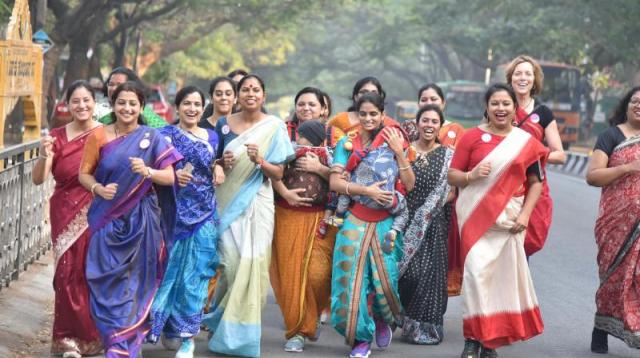
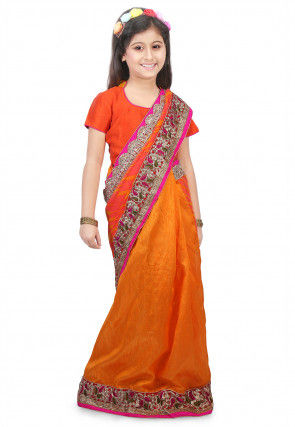






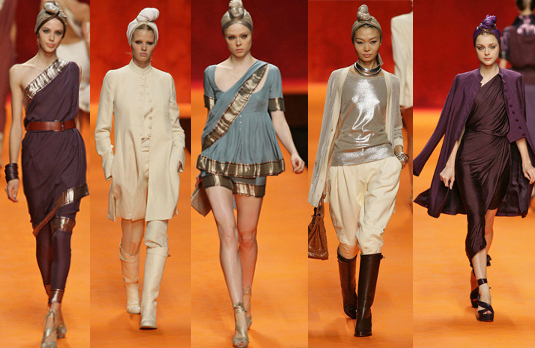
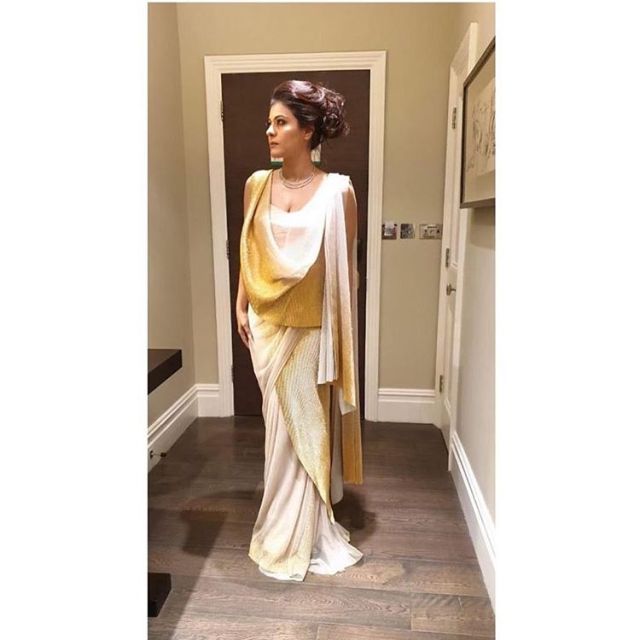
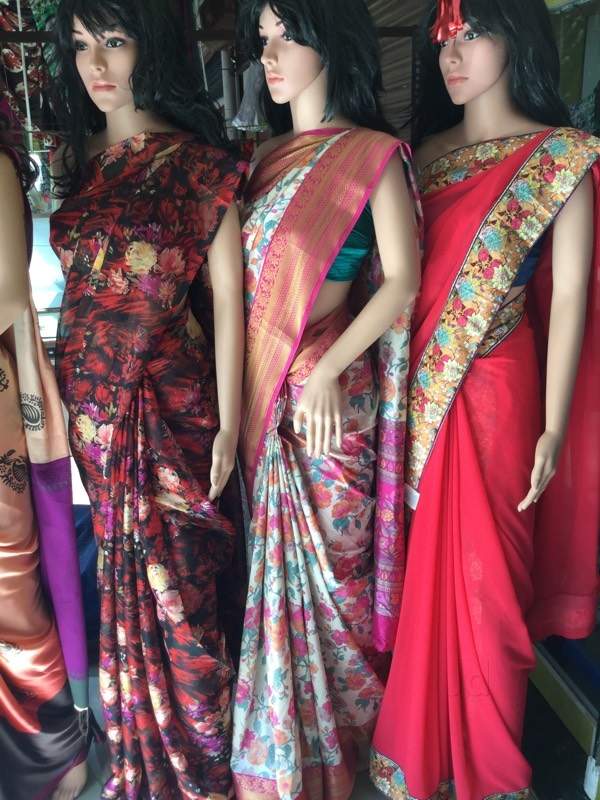






So happy that you wrote this piece, Zephyr! I agree with everything, everything! I vagguely remember we had once briefly talked about some things about these well-meaning attempts to revive the ‘handloom weaves’ and this ‘#100sareepact etc…Didn’t we? Or did I discuss it with someone else? In any case, there is definitely a concern whether such things make sari look more like some special/designer thing instead of a daily, regular wear for millions and millions of women throughout India. While I understand that there is a need for an urban, upper-class focused saree-revival movement, it somehow needs to be balanced with an awareness that sari is not something exclusive, display-worthy object only, it is as you say part of the civilisational identity which is more or less being preserved by those millions and millions who hardly ever do #100sareepact because they don’t need to. They wear sari everyday because that’s part of their identity, it is not to be shown off in any way!
LikeLike
You know why I love your comments? Because they understand EXACTLY what I am trying to say in the post, any post. Thank you, and a big hug for that to start with! I don’t remember us discussing the saree pacts and swags, so it must have been someone else you discussed it with. But I am so happy you share my feelings about the sari becoming designer while the read sari wearers continuing to wear them without any selfies! Only, I always stop these beautiful women going to do housework and compliment them on their looks, their accessories and how elegant and lovely their demeanor and swag! Yes theirs is real swag as they sweep and mop and clean in their gorgeous nylex sarees! Another hug to you to close my reply!
LikeLiked by 1 person
A big hug to you too, akka!
LikeLike
As you said, it is the less visible everyday woman who will #SaveOurSarees not the #SareeSwag crowd. But the #SareeSwag crowd are serving the cause too. But for their effort, the Saree would disappear from the wardrobes of the urban Divas.
I remember going to a business seminar in Bombay. It was monsoon and had been raining the zoo. I being who I am, wore a Saree for the meeting. The lady conducting the seminar, arrived–two hours late–wearing a trouser and jacket suit… in a rather unfortunate shade of indigo. After the meeting, she and one of her yes-men decided to teach me a thing or two about ‘professional apparel’.
I heard them out and sweetly told them I’d rather stick to my saree. AND I’d make sure I got ready well in time to be punctual to meetings.
I don’t think the lady liked me frightfully, alas.
LikeLike
I would have loved to see the face of the seminar lady when you gave her the ‘Dagny treatment’:D I would have worn a saree too, but being me, I would have worn a synthetic one, and probably got a lecture from her for wearing artificial fabric!
And oh, I have mentioned that the social media initiatives are helping get new recruits to the saree-fold (pun intended) and that it is also helping the weaver communities and to revive and showcase the exquisite weaves of our country. How come it has become invisible? Even Siddharth mentioned it. Let me go and check if it has got left out in the numerous edits the post had undergone!
LikeLiked by 1 person
Good morning ZM! Been a long time I commented on one of your posts.
Off the bat, kudos on your dedication to wearing the saree and promoting it. I concur with you that it is a pity that arguably the most elegant Indian garment is today relegated to formal functions and religious ceremonies, at least in the metros. My sense is it is a combination of convenience and ease of wearing/care. Particularly about the latter, there seems to be a vicious circle where most young women (especially in cities) complain that they don’t wear sarees more regularly because they are difficult to wear and then to manage. Now as it stands, wearing and managing a saree is a matter of practice, so a saree is not worn often hence no practice and hence inconvenient so not worn often.
There is also no denying the negative publicity that the saree has received from certain quarters. I do believe that most of the criticism, of a saree being an instrument of patriarchal subjugation, is invalid. Carrying the thought from your post, a burqa is actually designed to cover all exposed skin including ankles (this is specifically mentioned in the edicts). As opposed to that, a saree draped properly is as much about covering skin as about showing the right amount of skin. So if at all, the saree is liberating because the woman wearing it decides how much skin she wishes to show. Mrs. Gandhi draped a saree around her shoulders and head and wore a full sleeves blouse to ensure 100% coverage. At the same time the pretty lady on the Seasons hoardings plastered across the city’s roads bears enough skin to actually pose a significant traffic hazard at the place where the hoarding has been put up.
There is just one point where I differ from your viewpoint. This pertains to the form that the saree takes/has taken. I understand that for everyday wear, cottons and polyesters make more sense but we must desist from attaching a snob factor to sarees purchased from FabIndia and/or other handloom showrooms or those made of more expensive materials like silk and chiffon. As a garment, everyone does not wear the saree so for some women, the elite material or the FabIndia brand provides the extra incentive. How many saree newbies do you think would be ready to walk into a bulk saree selling store and battle it out for a cotton saree amongst 30 other women attempting the same? Some want the air conditioned comfort and convenience to make the saree wearing experience complete and not seem like a chore. Not to mention that handloom emporiums and brands like FabIndia who favour handloom artisans over “mass produced in a factory” products are helping to keep alive a dying art. Our traditional weaver and handloom communities are already dwindling to the brink of extinction with handlooms going out of business and future generations leaving the family business to pursue other, more economically beneficial professions. In fact even if people make iterations of the saree as a dress, we should encourage it because it will help keep the saree alive. Maybe we need to look at it as evolution, as species evolve to avoid extinction. If we keep sticking to a puritan line of material and “correct way” to drape a saree, we risk alienating subsequent generations, making them dismiss the saree as a cumbersome vestige of our past and eventually contributing to the extinction of the beloved garment.
P.S. as usual, sorry for the blog length comment 😀
LikeLike
It has indeed been long since you came here because WP didn’t recognise you and I had to approve your comment! As for the length of the comment, if my post can be two-posts long, your comment can be one post long, surely? Loved your observation about the sari being an empowering garment because it gives the wearer the option to bare just the amount of skin she wants to. In the Tambrahm version, a teenie bit of the left shin is visible and that makes it such an alluring style, as per connoisseurs!
Hey, I never once in the post said that those wearing Fabindia or any other expensive weaves were snobs or that they should not promote them. All I said was that these efforts are indeed making youngsters look at the sari as an option and that is good. But not good enough to keep the sari alive. Yes, it does keep the weavers and the handloom industry alive and thriving. Most commendable. My point is that the ordinary woman wearing an ordinary saree should be considered the sari-ambassador because she will be the one who would ensure that the saree lives. we have to promote her #sareeswag, even if she is just wearing a Rs 200 sari! I am now wondering if I have failed to put my points across effectively 😦
LikeLike
Totally agree, the saree needs to be saved, a revolution is in order! Actually of late I have observed there are a number of SM sites, on FB especially devoted to this beautiful traditional garment. The current rage is all about traditional weaves like ikkat, pochampully,tant,linen,kalamkari,and embroidered works like kantha, chikankari etc. These pieces are rather exclusively priced but boy, they sure pack a punch when draped by any woman, any shape or size. Isn’t that the best part of a saree – one size fits all! The nine yards is a saree ideal for all kinds of physical activities, rather comparable to a dungaree! It’s a wonderful thing that many of our celebs flaunt these beauties during prominent stage and public appearances. Personally, I’ve started wearing sarees a bit more frequently, more due to the current trend of mix-n-match blouses since I never seem to have the right blouse for the right saree!
LikeLike
I love all the weaves, Kala. They are the ultimate in artistic creativity. The SM initiatives are going yeoman service to keep them alive, revive them and showcase them too. Also, in the bargain, they are motivating people like you to pick up a sari as an optional wear. But these efforts and the odd recruit is not enough to keep the garment alive. For that we need to motivate the regular users to stay there and continue wearing them, even if they only wear machine made artificial yarn that has no artistic merit in comparison. I have tried to highlight the fact that the saree by itself is a work of art and so should be promoted as such. By making these dedicated wearers feel inferior because they don’t wear handlooms, we’d only be hastening their departure to ‘comfort’ wear like jeans or salwar suits.
LikeLike